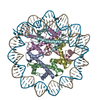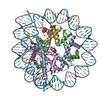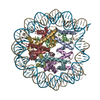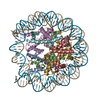+ Open data
Open data
- Basic information
Basic information
| Entry | Database: PDB / ID: 8eu2 | |||||||||
|---|---|---|---|---|---|---|---|---|---|---|
| Title | Class3 of the INO80-Hexasome complex | |||||||||
 Components Components |
| |||||||||
 Keywords Keywords | STRUCTURAL PROTEIN/DNA / Chromatin Remodeler / hexasome / DNA BINDING PROTEIN / STRUCTURAL PROTEIN-DNA complex | |||||||||
| Function / homology |  Function and homology information Function and homology informationstructural constituent of chromatin / heterochromatin formation / nucleosome / nucleosome assembly / protein heterodimerization activity / DNA binding / nucleus Similarity search - Function | |||||||||
| Biological species | synthetic construct (others) | |||||||||
| Method | ELECTRON MICROSCOPY / single particle reconstruction / cryo EM / Resolution: 2.93 Å | |||||||||
 Authors Authors | Wu, H. / Munoz, E. / Gourdet, M. / Cheng, Y.F. / Narlikar, G. | |||||||||
| Funding support |  United States, 1items United States, 1items
| |||||||||
 Citation Citation |  Journal: Science / Year: 2023 Journal: Science / Year: 2023Title: Reorientation of INO80 on hexasomes reveals basis for mechanistic versatility. Authors: Hao Wu / Elise N Muñoz / Laura J Hsieh / Un Seng Chio / Muryam A Gourdet / Geeta J Narlikar / Yifan Cheng /  Abstract: Unlike other chromatin remodelers, INO80 preferentially mobilizes hexasomes, which can form during transcription. Why INO80 prefers hexasomes over nucleosomes remains unclear. Here, we report ...Unlike other chromatin remodelers, INO80 preferentially mobilizes hexasomes, which can form during transcription. Why INO80 prefers hexasomes over nucleosomes remains unclear. Here, we report structures of INO80 bound to a hexasome or a nucleosome. INO80 binds the two substrates in substantially different orientations. On a hexasome, INO80 places its ATPase subunit, Ino80, at superhelical location -2 (SHL -2), in contrast to SHL -6 and SHL -7, as previously seen on nucleosomes. Our results suggest that INO80 action on hexasomes resembles action by other remodelers on nucleosomes such that Ino80 is maximally active near SHL -2. The SHL -2 position also plays a critical role for nucleosome remodeling by INO80. Overall, the mechanistic adaptations used by INO80 for preferential hexasome sliding imply that subnucleosomal particles play considerable regulatory roles. | |||||||||
| History |
|
- Structure visualization
Structure visualization
| Structure viewer | Molecule:  Molmil Molmil Jmol/JSmol Jmol/JSmol |
|---|
- Downloads & links
Downloads & links
- Download
Download
| PDBx/mmCIF format |  8eu2.cif.gz 8eu2.cif.gz | 218.3 KB | Display |  PDBx/mmCIF format PDBx/mmCIF format |
|---|---|---|---|---|
| PDB format |  pdb8eu2.ent.gz pdb8eu2.ent.gz | 158 KB | Display |  PDB format PDB format |
| PDBx/mmJSON format |  8eu2.json.gz 8eu2.json.gz | Tree view |  PDBx/mmJSON format PDBx/mmJSON format | |
| Others |  Other downloads Other downloads |
-Validation report
| Summary document |  8eu2_validation.pdf.gz 8eu2_validation.pdf.gz | 855.9 KB | Display |  wwPDB validaton report wwPDB validaton report |
|---|---|---|---|---|
| Full document |  8eu2_full_validation.pdf.gz 8eu2_full_validation.pdf.gz | 858.5 KB | Display | |
| Data in XML |  8eu2_validation.xml.gz 8eu2_validation.xml.gz | 33.8 KB | Display | |
| Data in CIF |  8eu2_validation.cif.gz 8eu2_validation.cif.gz | 48.8 KB | Display | |
| Arichive directory |  https://data.pdbj.org/pub/pdb/validation_reports/eu/8eu2 https://data.pdbj.org/pub/pdb/validation_reports/eu/8eu2 ftp://data.pdbj.org/pub/pdb/validation_reports/eu/8eu2 ftp://data.pdbj.org/pub/pdb/validation_reports/eu/8eu2 | HTTPS FTP |
-Related structure data
| Related structure data |  28602MC  8etsC  8ettC  8etuC  8etvC  8etwC  8eu9C  8eueC  8eufC  8eujC M: map data used to model this data C: citing same article ( |
|---|---|
| Similar structure data | Similarity search - Function & homology  F&H Search F&H Search |
- Links
Links
- Assembly
Assembly
| Deposited unit | 
|
|---|---|
| 1 |
|
- Components
Components
-DNA chain , 2 types, 2 molecules IJ
| #1: DNA chain | Mass: 69840.398 Da / Num. of mol.: 1 / Source method: obtained synthetically / Source: (synth.) synthetic construct (others) |
|---|---|
| #2: DNA chain | Mass: 70347.750 Da / Num. of mol.: 1 / Source method: obtained synthetically / Source: (synth.) synthetic construct (others) |
-Protein , 4 types, 6 molecules AEBFCD
| #3: Protein | Mass: 15403.062 Da / Num. of mol.: 2 Source method: isolated from a genetically manipulated source Source: (gene. exp.) Gene: LOC121398065, LOC108703785, LOC121398067, XELAEV_18002543mg Production host:  #4: Protein | Mass: 11394.426 Da / Num. of mol.: 2 Source method: isolated from a genetically manipulated source Source: (gene. exp.)  #5: Protein | | Mass: 14109.436 Da / Num. of mol.: 1 Source method: isolated from a genetically manipulated source Source: (gene. exp.)  #6: Protein | | Mass: 13655.948 Da / Num. of mol.: 1 Source method: isolated from a genetically manipulated source Source: (gene. exp.)  |
|---|
-Experimental details
-Experiment
| Experiment | Method: ELECTRON MICROSCOPY |
|---|---|
| EM experiment | Aggregation state: CELL / 3D reconstruction method: single particle reconstruction |
- Sample preparation
Sample preparation
| Component | Name: INO80-Hex / Type: COMPLEX / Entity ID: all / Source: MULTIPLE SOURCES |
|---|---|
| Source (natural) | Organism: |
| Source (recombinant) | Organism:  Homo sapiens (human) Homo sapiens (human) |
| Buffer solution | pH: 7.5 |
| Specimen | Embedding applied: NO / Shadowing applied: NO / Staining applied: NO / Vitrification applied: YES |
| Vitrification | Cryogen name: OTHER |
- Electron microscopy imaging
Electron microscopy imaging
| Experimental equipment |  Model: Titan Krios / Image courtesy: FEI Company |
|---|---|
| Microscopy | Model: FEI TITAN KRIOS |
| Electron gun | Electron source:  FIELD EMISSION GUN / Accelerating voltage: 300 kV / Illumination mode: SPOT SCAN FIELD EMISSION GUN / Accelerating voltage: 300 kV / Illumination mode: SPOT SCAN |
| Electron lens | Mode: BRIGHT FIELD / Nominal defocus max: 2000 nm / Nominal defocus min: 1000 nm |
| Image recording | Electron dose: 67 e/Å2 / Film or detector model: GATAN K3 (6k x 4k) |
- Processing
Processing
| CTF correction | Type: PHASE FLIPPING AND AMPLITUDE CORRECTION |
|---|---|
| 3D reconstruction | Resolution: 2.93 Å / Resolution method: FSC 0.143 CUT-OFF / Num. of particles: 233675 / Symmetry type: POINT |
 Movie
Movie Controller
Controller












 PDBj
PDBj






































